By Henry M. Holden
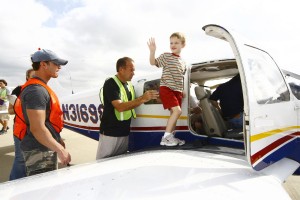
A Challenge Air participant waves from the wing before his first flight. He had his ground school training and is now ready to fly.
Rick Amber founded Challenge Air with the belief that every disabled person should see the world from a different view—”out of their wheelchairs and crutches and from the sky.”
Challenge Air for Kids and Friends, located at Love Field (DAL) in Dallas, is a nonprofit organization that offers motivational, inspirational and life-changing aviation experiences to physically challenged children and young people.
“We lost Rick to cancer in 1997,” said Byron Laszlo, Challenge Air executive director. “He touched the lives of thousands of special children and their families through Challenge Air. What we’re doing today is carrying on his legacy and what he saw as so necessary for these children. The Challenge Air program aims to inspire, motivate and empower children who are living with physical disabilities and serious illnesses, such as cancer.

Isabel Hoesterey, her family and their pilot pose for a photo after a flight over north Texas. Fly Days not only lift the children to new heights, but lift their parents’ spirits as well.
Amber was born and raised in Dallas. He graduated with a BS from the U.S. Naval Academy at Annapolis, in 1967. As a Navy fighter pilot, he flew F-8 Crusaders in Vietnam. The life of the 26-year-old changed drastically on his 109th combat mission, in 1971.
“When he was returning from that mission, the seas were high; he was attempting to land on the carrier USS Hancock when his landing gear failed,” he said. “His plane crashed, and he ejected out of a fireball. He landed on part of the ship and broke his back. He was alive, but he came out of it as a high-functioning quadriplegic.”
After Amber’s accident, he decided to pursue higher education. In 1978, he earned an MS in environmental science, from the University of Texas in Dallas, and a BA from Southern Methodist University in 1984. He was teaching math and science at the Greenhill School in Dallas, when the administrator asked him to design an aviation class curriculum. He realized how much he missed flying.
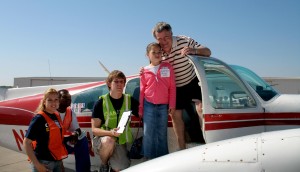
John Wing of Wing Aero, volunteer pilot and Challenge Air advisory board member, poses with Fly Day participant Jocelyn Nelson and other volunteers.
Amber began teaching ground school in the evenings, in exchange for the flying hours he needed to become a civilian pilot. In less than a year, he earned his license as both a commercial pilot and certified flight instructor. Including his Navy time, he had 3,500 hours of flying. He held every available flight and instrument rating and remained current in his ratings by passing the FAA flight check every six months.
Amber also had athletic interests and accomplishments. He won the United States Tennis Association (U.S. Open) National Tennis Wheelchair Championship, Men’s Singles Division, in 1993. When he was asked to teach a wheelchair tennis clinic for physically challenged young people, his work with children began in earnest. He realized he was in a unique position to also share his love of flying with “kids on wheels.”
“In 1993, Rick purchased a Cessna 177B Cardinal, and Challenge Air was born,” said Laszlo. “He named the airplane Crusader after the jet he flew in the Navy, and for his passion to bring his experiences to children.”
Amber ordered specially designed hand controls, and had the aircraft modified with large doors and overhead pull handles. The dual-control aircraft seats four passengers and is ideal for boarding and un-boarding disabled children.
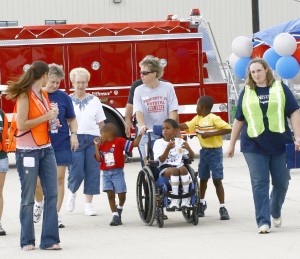
Volunteers escort a family out to the ramp. The boy is about to see the world from a new perspective.
“Then he invited about 12 children from the Dallas Spina Bifida Association to the airport, for a day of fun,” said Laszlo.
Spina bifida is a permanently disabling birth defect, when the spinal column doesn’t close completely during the first month of pregnancy. The effects are different for every child. Up to 90 percent of children with the worst form of spina bifida have hydrocephalus (fluid on the brain) and must have surgery to insert a shunt that helps drain the fluid. The shunt stays in place for the child’s lifetime. Other conditions include full or partial paralysis.
“Rick took the children to Addison Airport (ADS), in a suburb of Dallas, for flights over the city’s famous skyline,” said Laszlo. “Million Air in Addison, saw his commitment and donated the fuel. The effort was a huge success, based on the enthusiastic responses he got from the children and their families. Rick instantly became committed to Challenge Air, so he could provide the experience of flying to children wherever he traveled.”
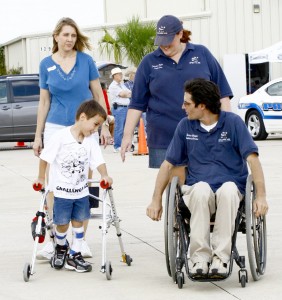
Linda Lauchner (left), with son Jason, on the ramp with Theron Wright, Challenge Air chief wheelchair aviator, and volunteer Catrina Clack. Although Wright was paralyzed in a work-related accident, Rick Amber inspired him to fly.
Amber saw reactions in each face of these special needs children, when they sat in the copilot’s seat and actually helped fly the plane. He realized this was a unique way to reach them.
“Rick was sending a message: ‘You can do anything you put your mind to. Just look at me. I’m in a wheelchair overcoming my challenges, to accomplish my dream to fly.’ He told them, ‘The sky’s the limit,'” Laszlo said. “That really set the stage for the organization.”
Amber obtained Challenge Air’s status as a nonprofit organization. Over the years, he flew more than 3,500 special needs children who came to his events, coast to coast.
“I began to look into the aviation field at a very young age and planned my life around flying,” one child wrote. “When I had my accident, I thought my dream was over. But I was wrong. Challenge Air showed me that I could still be a pilot. Dreams don’t have to disappear, but sometimes attitudes do!”
In addition to his passionate commitment to Challenge Air, Amber became involved with several community service and professional organizations, while also serving in an advisory capacity for Dallas County and its Dallas Area Rapid Transit department. He served as a board member at the Martin Luther King Center and with the Private Industry Council. He also served as an associate member of the American Therapeutic Recreation Association and the National Recreation and Parks Association.
Fly Day
More than 4,242,000 children in the United States have disabilities.
“Since 1993, more than 22,000 special needs children have gone through the Challenge Air program across the country,” said Laszlo. “We’ve hosted an event we call Fly Day in 11 Texas cities, and in almost two dozen cities in 21 other states.”
The events are usually held on Saturdays. Typically, about 15 to 20 private planes owned by both physically challenged and able-bodied volunteer pilots participate.
Fly Day events are free to children 7 to 17 years of age, along with their families. Generally, about 125 children are served at each privately funded event.
Weather, time and safety permitting, one of the goals of the event is to provide the opportunity for the children to participate in an actual flight. The Fly Day is a great introduction to flight, but more importantly, it’s where these special children are empowered by the flight experience—to look beyond perceived physical or mental limitations
“We test their ability, and teach them to set personal goals, to experience achievement and to look ahead to a more enriched life,” said Laszlo.
The children attend a mandatory ground school, where they watch short presentations
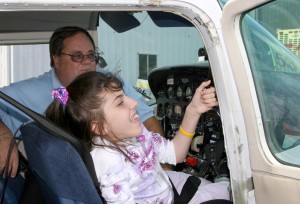
Lauren, a veteran copilot, gives a “thumbs up,” indicating she’s ready to take to the skies over Fort Lauderdale, Fla. She’s flown for several years in the Challenge Air program.
about the dynamics of flight, aviation studies and the aviation industry. Hands-on educational areas offer fun learning experiences that reinforce concepts learned at the ground school. These activities include building model airplanes and rockets, using flight simulators, and providing the opportunity to explore a real airplane on the ground. The learning activities are adjusted for age and ability.
Except for Challenge Air’s four full-time staff members, the organization is all volunteer.
“Our Fly Days are successful because of our volunteers,” said Laszlo. “Challenge Air recruits and trains volunteer pilots from organizations such as International Wheelchair Aviators, the Flying Rotarians (a Rotary International worldwide fellowship), the Experimental Aircraft Association, Women in Aviation, the 99s and others.”
Many of the volunteer pilots have overcome their own physical challenges to accomplish their dreams to fly. Volunteer pilots spend quality time with their young copilots, and encourage them to take the controls and to fly the planes themselves.
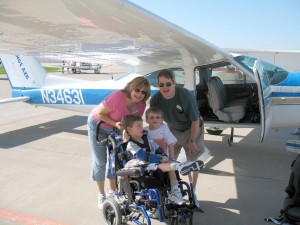
A family poses by Challenge Air’s Cessna 177 after a flight. Before their flight, these children had no idea they could fly a small airplane.
Each volunteer pilot must have a valid pilot’s certificate and a current medical certificate. All aircraft must have all proper maintenance and inspections completed, and must have an insurance certificate listing Challenge Air as an additional insured.
Each child Challenge Air takes for their first ride also becomes a Young Eagle since Challenge Air supports EAA’s Young Eagles program.
“We’re a little organization, working on a big mission for these children,” said Laszlo. “Challenge Air collaborates with other organizations serving the same population of children who would benefit from this program. These include athletic groups for youth with disabilities and physical/occupational/recreational therapy groups.”
Challenge Air plans to develop a number of additional aviation programs designed to provide long-term benefits to physically challenged youth. Such programs will include a mentor program for those who are interested in aviation careers, an aviation studies scholarship program and an internship program that will link Challenge Air youth with major aviation industry employers.
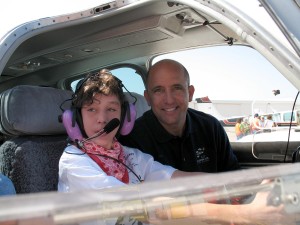
Greg Larson, volunteer pilot and Challenge Air advisory board member, is with a special copilot who’s preparing for the flight of a lifetime.
“With an increased demand for the Fly Day program, we anticipate that in 2007, at least 1,375 children living with physical challenges or life-threatening illnesses will be inspired by the unique, once-in-a-lifetime experience that is Challenge Air,” said Laszlo.
As Rick Amber says, “The human spirit prevails over any physical or mental obstacle. After a day with Challenge Air, no height seems unreachable. all it takes is desire and truly, the sky is the limit!”
For more information, visit [http://www.challengeair.com].












